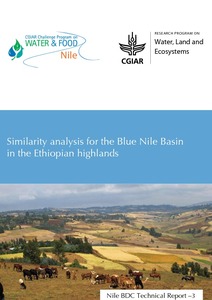Resource information
Up until today, rainwater management practices have been promoted regardless of site-specific biophysical characteristics and regardless of the socio-economic and institutional environment. Therefore, low adoption rates and high disadoption rates of rainwater management practices are observed. In order to promote rainwater management more successfully, a paradigm change towards promotion of location-specific interventions is needed. Beyond biophysical suitability, successful implementation crucially depends on farmers’ willingness to adopt a practice. Therefore, the socio-economic and institutional environment must be taken into account in a spatially explicit way. A first step towards the promotion of site-specific rainwater management requires an understanding of which sites present similar biophysical, socio-economic and institutional characteristics within a basin. The objective of this report is twofold. Firstly, it aims at presenting the available spatial data for the Blue Nile Basin in the Ethiopian highlands. Secondly, it develops a methodology that allows identifying locations within a landscape that have similar biophysical, infrastructure, socio-economics, and governance characteristics relevant to rainwater management.



